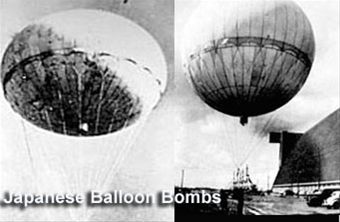![]() The Pacific War Online Encyclopedia
The Pacific War Online Encyclopedia
|
| Previous: Balikpapan | Table of Contents | Next: Baltimore Class, U.S. Heavy Cruisers |

Balloon bombs (Fu-go)
were a Japanese innovation.
When the Japanese found themselves unable to retaliate by any
conventional means against the Doolittle Raid, the Noborito Reasearch Institute
developed designs for large (13' or 4 meter) hydrogen-filled
balloons armed with incendiary and antipersonnel bombs. The
balloon bombs were equipped with automatic mechanisms to release
ballast or hydrogen in order to maintain altitude within the jet stream. The jet
stream would carry the balloons to North America within a matter
of days, and a timing mechanism would then release the bomb load.
The Japanese hoped to start large forest
fires in the Pacific Northwest and spread panic among the civilian population.
According to Sears (2008), the balloon bomb program was known as Flying Elephant and was seen as a way for ordinary Japanese to share in the spirit of the kamikazes. Each balloon required the assembly of 600 strips of washi, a paper made from mulberry (kozo) bark using using paste made from the corms of the konnyaku plant. The work was often done by schoolgirls or sex workers supervised by paperhangers, working under brutal conditions and fed stimulant pills they were told were vitamins. The balloons had a simple pressure relief valve to vent hydrogen when the balloon was heated during the day, keeping its altitude below 40,000' (12,000m), while a set of barometers fired black powder blowout plugs to release ballast if the altitude dropped below about 26,000' (8000m) during the night. The mechanism was powered by a battery insulated from the extreme temperature changes at altitude with an antifreeze solution. Up to four incendiary bombs and a 36lb (16kg) antipersonnel bomb were released when a sufficient number of blowout plugs had fired. The balloon then self-destructed using a magnesium flash bomb connected to the balloon envelope by a long fuse.
Launch sites were constructed near Otsu (140.7833E
36.8333N), Ichinomiya (140.3800E
35.3721N), and Nakoso (140.3555E
35.4596N), and where the sites would be distant from
Japanese population centers but accessible by rail. Otsu also had its own
hydrogen plant.
The first balloon bombs were launched in November 1944.
The first serious notice the Americans took of the devices came on
3 November, when a balloon was observed to release its
antipersonnel bomb near Thermopolis, Wyoming. A balloon bomb in
"pristine" condition was recovered from Alturas, California, and
it was carefully studied and test flown by the Air Force. The
principal American response was to impose a press blackout to
prevent the Japanese gaining any information on the
effectiveness of the bombs. Hearing of no reports of the weapons,
the Japanese concluded that the weapons had been ineffective and
ended the balloon bombing campaign six months later. In fact, of
the 9300 bombs released, remains of 285 were eventually
discovered, and it is estimated that about 1000 reached North
America. One bomb made it as far as the suburbs of Detroit.
However, the only significant damage or casualties inflicted by the
bombs were the deaths of a pastor's
wife and five children who
discovered a balloon bomb while on a picnic near Bly, Oregon.
These have been described as the only direct civilian casualties
from enemy action in the U.S. mainland during the war. The Bly
deaths led to severe criticism of the policy of censoring all
information on balloon bombs, and restrictions on press reports
were effectively lifted in May 1945, following a ham-handed
attempt to warn selected civilians by word of mouth.
Because the balloons relied on the jet stream, which
lies above the storm track, it was almost guaranteed that the
balloon bombs would drop only on forest that was soaked by rain.
The Japanese were aware of this, but inflated the accomplishments
of the campaign in their domestic propaganda, claiming that
the "fireflies" had set forests ablaze, killed 10,000 Americans,
and carried Japanese infiltrators deep into the United States.
The Japanese Navy made its own effort to develop a
balloon bomb program, but their Type B balloon (the Army's was
designated Type A) was constructed of rubber-impregnated silk. The
design was nearly unworkable and the program was eventually
cancelled due to the lack of raw materials.
American officials were concerned about the possibility
that the Japanese would arm the bombs with biological
agents and quietly took precautions, such as distributing
disinfectant to decontaminate balloon bomb wreckage. A number of fighters were assigned to air
defense against the balloons and succeeded in shooting down about
20 of the weapons. Some 200 paratroops were assigned to
stand by for "smoke jumper" duty, but found themselves mostly
fighting fires from more mundane causes. American intelligence pinpointed
the Ichinomiya site from shrewd guesswork based on backwards
extrapolation of the balloon trajectories and analysis of the sand
in the ballast bags. This was confirmed by aerial reconnaissance,
but by then the danger was mostly past (due to summer changes in
the jet stream pattern) and no effort was made to bomb the launch
sites.
Ironically, this attempt to burn out the cities of the Pacific Northwest preceded by two or three months the first of the much more successful American fire bombing raids against Japanese urban areas.
References
U.S. Air Force (2010; accessed 2010-12-1)
The Pacific War Online Encyclopedia © 2010-2011, 2015, 2017 by Kent G. Budge. Index